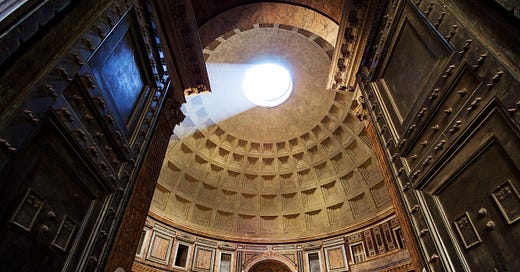Using Ancient Techniques for Modern Problems
Our current designs aren't sustainable for the rapidly changing climate, so let's look at ancient solutions to beat the heat, cool down, and make structures last
Hiya!
I don’t know if you’ve noticed… but the climate is becoming increasingly unstable. Natural disasters are already familiar headlines reporting massive flooding, droughts, wildfires, hurricanes, freak tornadoes, and even the once elusive snow lightning. These events kill tens of thousands, destroy communities, and cost the global economy hundreds of billions of dollars in damages every year.
Surveying the destruction makes one thing clear. We are not designing our homes or cities with the climate in mind. I know we usually turn to technology to solve our problems, but in this case, technology is part of our problem. The good news is, our ancient ancestors lived for hundreds of thousands of years without technology—including surviving not one but two ice ages, which means perhaps we can adapt some of their techniques to help us solve our modern problems.
Modern Concrete
One thing we’re becoming increasingly dependent on is concrete. While not a technology in the digital sense, it’s still a human-made material. In 2021, researchers found that concrete was the second most consumed material in the world — the first was water. In other words, we use it all the time. We use concrete to build roads, buildings, and bridges because not only is it durable, but affordable too. Win-win.
Except there’s a catch. See, concrete is the product of several mixed materials, including water, sand, gravel, various chemicals, and cement. I used to think cement and concrete were the same, but they aren’t. Concrete is the finished product, while cement is the glue that holds it all together, giving the concrete its strength and grey coloring.
It’s no wonder cement manufacturing increased by 20 percent between 2011 and 2020. After all, cities are referred to as “concrete jungles.” Unfortunately, concrete is a significant contributor to our climate problems as the third largest greenhouse gas emitter. Plus, global warming is not kind to concrete, it’s increasingly diminishing concrete’s versatility.
Thankfully, solving this issue offers plenty of opportunities to discover or rediscover alternative techniques to our modern concrete mixtures. For instance, MIT researchers created emissions-free concrete in 2019, but it turns out that the ancient Romans had a pretty great method too.
Roman Concrete
I’ve traveled a fair amount but walking into the Pantheon in Rome, Italy, left an impression. Despite being over 2,000 years old, it’s the largest unreinforced concrete dome in the world! Somehow, it’s stood the test of time, and you can’t help but feel as tiny as a mouse beneath its roof. While its dome is awe-inspiring for tourists, the mystery behind the Pantheon’s endurance has confuddled experts’ minds for years.
Keep reading with a 7-day free trial
Subscribe to Curious Adventure to keep reading this post and get 7 days of free access to the full post archives.



